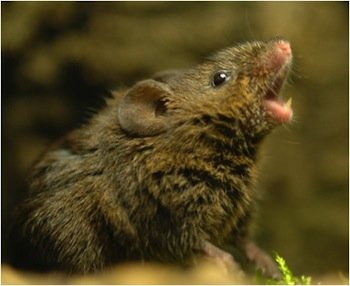Singing Mice and Scientific Breakthroughs
Some mice in Costa Rica can produce a song very similar to that of birds.

The singing mouse Scotinomys teguina chirps up to 20 times per second. Both males and females chirp, though males chirp more. Their song may seem like birdsong to humans, but the mouse song is usually composed of only one note. Image from Bret Pasch and audio of the mouse singing are from www.tacc.utexas.edu (the song is played back at a slower rate to demonstrate its complexity).
Have you ever heard a mouse sing? Some mice in Costa Rica can produce a song very similar to that of birds, only the mice are monotonal (using only one tone). These mice, called Scotinomys teguina, communicate in a series of chirps, sometimes chirping as fast as 20 times per second!
The mice chirp because of a gene called FOXP2. People also have a version of the FOXP2 gene in their genetic code. Even a small mutation—a change in genetic information—in the human FOXP2 gene can cause problems such as autism and speech disorders. Scientists have decided to study the FOXP2 gene in singing mice to see if they can discover why these disorders occur in people. Maybe they can find a cure!
Often we see “evolution” get credit for medical breakthroughs, but if Phelps [the scientist leading the study] learns something from singing mice applicable, for instance, to autism, it will not be a proof of the importance of evolutionary belief—as we so often hear—but rather a deciphering of the genetically designed similarities that bears fruit. Our common Designer naturally uses many common designs, from genes to anatomical structures, to perform similar functions in different kinds of animals and people. 1
– Dr. Elizabeth Mitchell
To learn more about design features and mutations, please see:
- Evolution and Medicine
- Frog Teeth Causing Controversy Among Evolutionists
- Mutations Q & A
- Scientists Create Singing Mouse?
1Elizabeth Mitchell, News to Note, August 25, 2012, Answers in Genesis, http://www.answersingenesis.org/articles/2012/08/25/news-to-note-08252012
Recommended Resources
- © 2024 Answers in Genesis
- Privacy Policy
- Contact
- About



